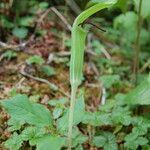Tuber subglobose, 1.2-3 cm in diam. Cataphylls 1 or 2, whitish, occasionally brown, to 20 cm, membranous, apex acute or obtuse. Pseudostem, petiole, and peduncle pale green, unmarked. Leaves 1 or 2; petiole (2.5-)20-52 cm, proximal 4/5 sheathing and forming pseudostem; leaf blade palmate; leaflets 5(or 7 or 9), sessile, ovate, oblong, or lanceolate, base attenuate, apex acuminate; central leaflet 7-18 × 2.5-7 cm; lateral leaflets 3-7 × 0.8-2.5 cm. Peduncle as long as petioles. Spathe green outside, greenish inside; tube cylindric, 2.5-8 cm × 8-20 mm, throat obliquely truncate, not recurved; limb arching over spadix, ovate to narrowly ovate or oblong-triangular, 2.5-5(-9) × 1-2.5(-3.5) cm, apex acuminate into ascending filiform tail 2.5-6 cm. Spadix unisexual; female zone 1.5-3 cm × 5-7 mm; ovary greenish, narrowly ovoid; stigma spherical; male zone cylindric, 2-3 cm × 3-3.5 mm; synandria sessile, lax, cream-colored or tinged dark purplish; anthers 2-4, dehiscing by apical pores or slits. Appendix greenish proximally, purplish distally, 2-8 cm × ca. 1 mm, distal part emergent from spathe tube horizontal to decurved, tapering, base swollen, truncate to 3-5 mm in diam., shortly stipitate, smooth. Fl. Jun-Jul. 2n = 52.
More
A herb. It grows to about 70 cm high. It forms tubers. There is usually one leaf divided into 5-9 lobes. These lobes are narrow and long. They have a long point. They are 5-15 cm long. The flower bract is green with white stripes. The tip is like a tail and curved upwards. It is 15 cm long. The fleshy flower stalk is 3.5-9 cm long. It is slightly curved.
It grows in temperate and subtropical climates. It grows in coniferous forest, open grassy place in forest, rhododendron or junipers thickets, forest margins between 3000-4300 m altitude in China. It grows from 2700-4000 m altitude in Nepal. It is frost hardy.
More
Shrubberies and rocky slopes in upper forest and lower alpine zones in drier areas of the Himalayas; at elevations from 2,400-4,000 metres. Coniferous forests, open grassy places in forests, Juniperus or Rhododendron thickets, forest margins.


